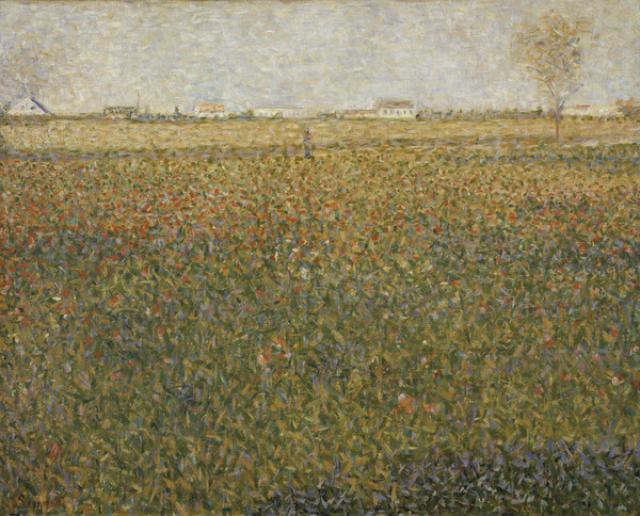Post-Impressionism
A broad-ranging term covering the variety of painting styles that emerged in the wake of Impressionism in Europe, particularly in France. The most prominent artists to arise from the group are Georges Seurat, Paul Cézanne, Vincent van Gogh and Paul Gauguin.

From Impressionism to Post-Impressionism
British painter and critic Roger Fry first coined the term Post-Impressionism in his controversial exhibition, Manet and the Post-Impressionists, at Grafton Galleries, London in 1910. The show was an attempt to unify an informal group of artists working predominantly in Paris in the giant shadow of Impressionism, who were influenced by their predecessors, yet determined to advance. As such, Post-Impressionism was never a specific movement with clearly defined goals or members; instead, it has become a catch-all term covering the diversity of styles that evolved in the late 1800s.

In his exhibition catalogue Fry wrote, ‘The Post-Impressionists consider the Impressionists too naturalistic'. As early as 1886, the date of the last Impressionist exhibition, many of the next generation’s artists were seeking an art with deeper meaning and more solid form, in contrast with the outwardly focussed and ephemeral nature of Impressionism.
Seurat and Cézanne
Georges Seurat and Paul Cézanne began their careers first as Impressionists, taking part in several of their exhibitions, before advancing with their own styles. On experimenting with the Impressionists’ ‘dappled’ brushstrokes Seurat developed a highly distinctive method of applying ‘dots’ of pure colour in contrasting tones onto the canvas in a style known as Pointillism, more commonly associated with the slightly earlier, Neo-Impressionists.
French artist Cézanne spent two years working alongside the Impressionist Camille Pissarro, from whom he learned about the effects of light and naturalistic colour. However, unlike the Impressionists, Cézanne was drawn to the basic geometric components of the natural world and famously said to Emile Bernard in 1904: ‘Treat nature in terms of its geometrical shapes of the sphere, the cylinder and the cone.’ His interest in multiple perspectives, where objects are seen from varying viewpoints and with faceted angles, are demonstrated in his later still-lives and his Montagne Sainte-Victoire series from 1890-95. Such paintings were revolutionary and paved the way not only for Cubism but for many more abstract styles to come, with Pablo Picasso describing Cézanne as ‘the father of us all.’
Japonisme, Synthetism and Symbolism
Like Cézanne, the Dutch artist Vincent van Gogh passed through Impressionism in his early career. He moved to Paris in 1886, where he was influenced by the work of Degas, Gauguin and Seurat, but said, ‘Instead of trying to reproduce exactly what I have before my eyes I use colour more arbitrarily so as to express myself more forcibly.’ After a brush with the Neo-Impressionist style, as seen in Orchard in Blossom (Apricot Trees), 1888, he later developed his distinctive and renowned style of swirling brushstrokes and intense emotion, expressed with vivid colours. He was a hugely prolific artist, despite his ongoing mental health struggles. In the 1880s van Gogh established a tumultuous friendship with French artist Paul Gauguin and together they shared numerous ideas, particularly a fascination with the flattened colours and dark outlines of Japanese Ukiyo-e prints, which they developed together into the Japonisme style. In the autumn of 1888, the two artists shared an apartment and studio space in Arles, where they lived and worked together. At this time Gauguin was developing his Synthetism theory, where works of art were a ‘synthesis’ of real appearance, the artist’s feelings and abstract lines or forms. He painted subjects from religion, literature and mythology, as seen in his Vision of the Sermon, 1899. The emotional and mythological content in their paintings meant both artists were closely tied with the concurrent Symbolist movement that emerged in France.
Post-Impressionism beyond France
In line with van Gogh and Gauguin, Norwegian artist Edvard Munch bridged the gap between Post-Impressionism and Symbolism with his angst-ridden, highly expressive paintings and prints, while Belgian artist James Ensor explored the ways flattened forms and heightened colours could invoke a sense of urban malaise. In America, Maurice Prendergast was highly influential; he lived in Paris in the 1890s, where he absorbed ideas around Impressionism, Post-Impressionism and Symbolism. In 1913 he helped to organise the Armory Show, which introduced European modernism to American society.
Legacy
Fry’s Post-Impressionist exhibition introduced the wider British public to French modernism in 1910. The show was ridiculed by the press but presented a turning point for many radical British artists, including the forward-thinking Bloomsbury Group who quickly absorbed the new ideas. Post-Impressionist ideas were brought to Russia by the World of Art group, where they had a lasting influence on Natalya Goncharova and Mikhail Larionov, who founded Neo-Primitivism. Fauvism in Germany was also borne out of Post-Impressionist ideas, signalling the beginning of a new era in art.










